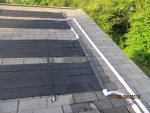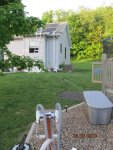Hey,
This is a very informational forum.. I have a question on the pump and solar panels. I hope some one can help. I have had 2 2x20ft panels up on my roof for 2 years now and I this past week end added 2 more. I put them in series with the other 2. I have a 1hp pump and I'm about 20 ft away from the house with about a 3 ft drop down to the pool from the house. I have the panels up 1 story
on the roof. Most of my plumbing is 1 1/2 pvc. The connections to and from the panels are the clear hose 1 1/4 with the nylon embedded in it. My problem currently is on the last panel the hose connection is starting to suck close not completely but over half way. If I crack the hose clamp there I can hear is suck air along with the water going past. Is this a problem? Pump pressure looks about 18psi
Thanks
This is a very informational forum.. I have a question on the pump and solar panels. I hope some one can help. I have had 2 2x20ft panels up on my roof for 2 years now and I this past week end added 2 more. I put them in series with the other 2. I have a 1hp pump and I'm about 20 ft away from the house with about a 3 ft drop down to the pool from the house. I have the panels up 1 story
on the roof. Most of my plumbing is 1 1/2 pvc. The connections to and from the panels are the clear hose 1 1/4 with the nylon embedded in it. My problem currently is on the last panel the hose connection is starting to suck close not completely but over half way. If I crack the hose clamp there I can hear is suck air along with the water going past. Is this a problem? Pump pressure looks about 18psi
Thanks


 Welcome to TFP!!!
Welcome to TFP!!! 
